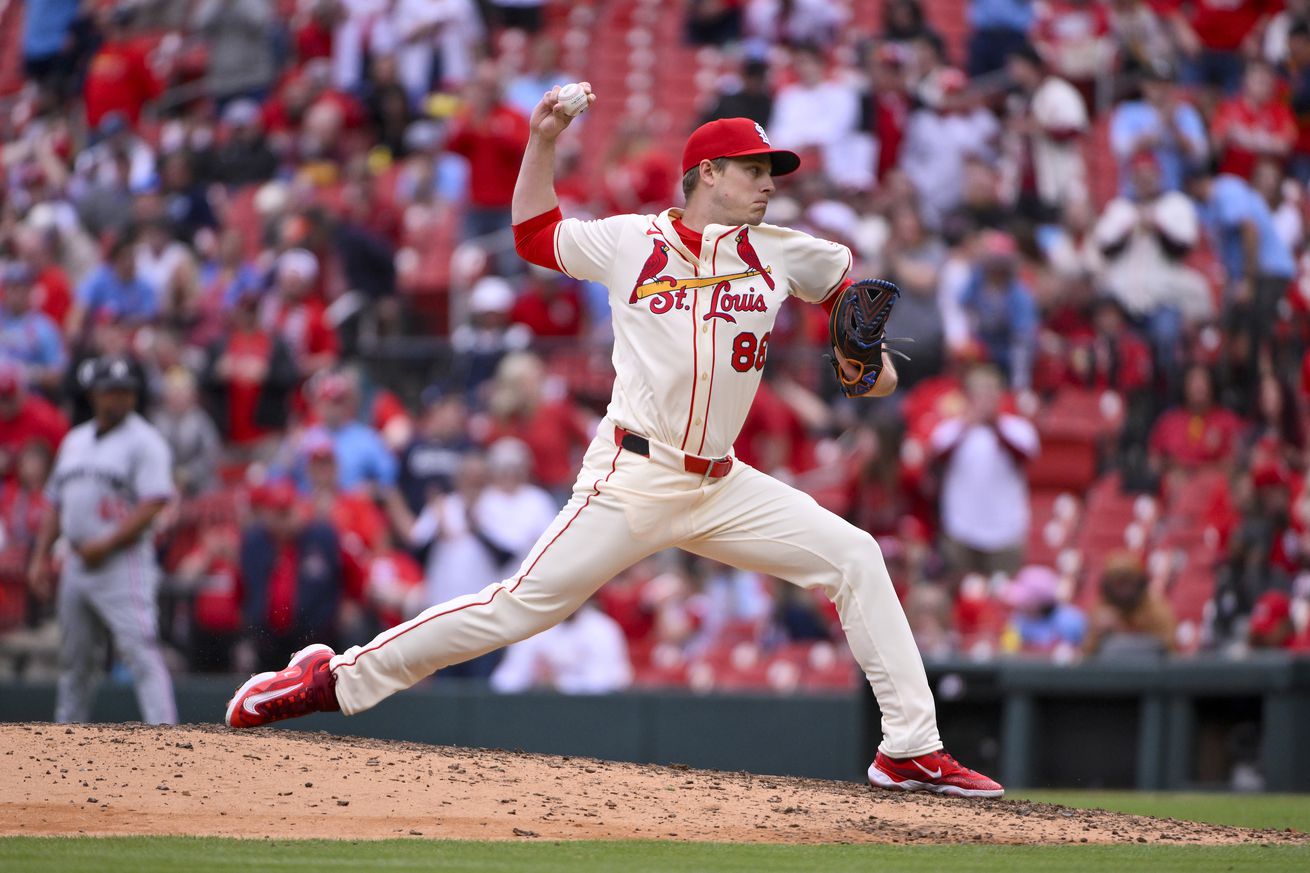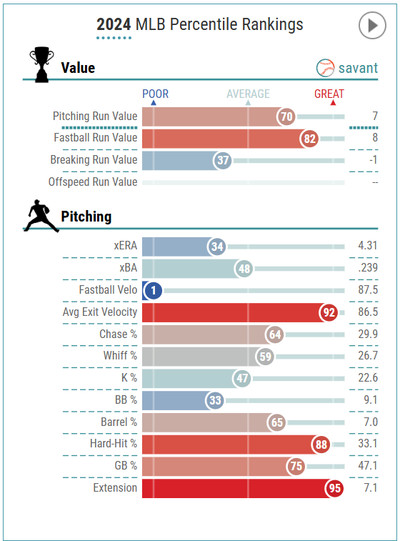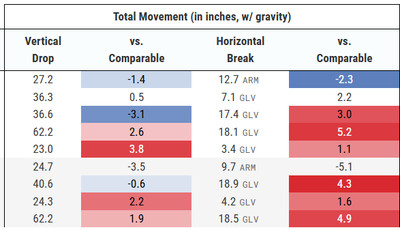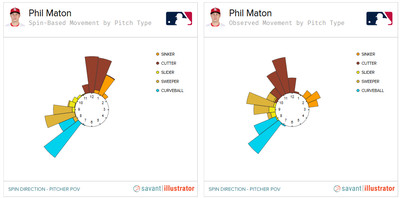
A deep dive on the Cardinals’ latest addition to their bullpen
As a long-time VEB reader, one of my favorite topics to consume was when Blake would do a deep dive on a pitcher, trying to convince us why Andre Pallante was so interesting or what not. These articles contained all kinds of good stuff that I devoured.
We’d get radial charts showing how pitches coming out of the same slot with opposite spin rates would look the same to a hitter but break in different directions at the last minute (It took me forever to figure out where he got these charts from). It helped us see the technology that was revolutionizing baseball and helped us understand how pitcher’s evolve, beyond our own boyhood experiments like putting more pressure on a seam or scratching the cover of the ball on the concrete.
It’s been a while since I’ve seen an article like that, so I think I will try my hand at it. Be forewarned, this is a version 1.0 of this type of article for me. I’ve never done an individual player breakdown before. I’m a novice, not a maestro like Blake. If it works out, I will work on it and try and improve. In comments, let me know if there is something about his profile you think I should have included, or interpreted differently. As always, the discussion and debate is half the fun.
Demographics
My topic of choice today is a pitcher breakdown on recently acquired Phil Maton, whom I knew very little about before embarking on my little research project.
2025 will be his age 32 season. Primarily a RH middle reliever, he carries a 4.00 career FIP. Right smack on my personal dividing line between good and ok. Over his career, he has featured a pretty standard 3-pitch mix that he uses almost evenly (cutter, curve, slider) at about 30% each with a small bias to the cutter, plus sinker mixed in less than 10% of the time. Note that different sites seem to refer to his slider as more of a sweeper. The slider is much harder and thrown much less, so it is easily picked out.
Like many middle relievers, he has moved around a bit. He started with the Padres in 2017, went to Cleveland, then Houston and then the Rays and Mets last year. He has been traded in mid-season three times already in eight years of MLB pitching, so he is used to forwarding his mail. It does not go unnoticed that he has passed through four of the more highly regarded pitching development organizations in baseball (if you believe the latest razz about the Mets) after leaving the Padres. I suspect intel from him on their pitching labs alone might be worth the $2m they are investing in him. It’s not really $2m, because they were going to pay someone at least $800,000 to do what he does, so the veteran presence premium is $1.2m at most.
Early in the article, I describe a few thumb nail statistics that covered his career. I will focus the rest of the article on his 2024 results. I will occasionally reference earlier results but generally view the older data as more stale and less instructive about who he is as a pitcher today.
League-wide Pitcher Comparison
Maton’s 2024 rankings against other MLB pitchers is shown below. I like the red colors, and dislike the blue.

Something I notice is the odd dichotomy that his FB velo is among the lowest in the league, yet the FB run value is in upper 20th percentile. It might be hyperbole to call it “elite”, but in comparison to the league, it is quite good.
Overall, his profile is one of generating lots of weak contact.
The Run-Value on the Fastball
Part of his recipe starts with extension. He generates extension at an elite level, 95th percentile. This is not a tweak – it has been this way since he broke in. For us old schoolers, this means he is closer to the plate when he releases the ball. So, while it isn’t a particularly rapid FB (87.5 mph), it travels a shorter distance, so the velo the hitter perceives is higher than what the radar gun (another old school term) shows.
One thing I noticed across his career arc – he started off throwing much harder (93.5 mph), but it was a 4-seamer with arm side run and his results weren’t great, having negative run values on that FB. He has since downshifted to the cutter (and lost velo every year), but as the glove side run improved, so did his results. It turns out velocity isn’t everything. He throws this cutter consistently up in the zone.
Pitch Movement

Not to belabor the FB too much, but here is the visual showing that his FB has an above average rise and sometimes even above average run. When you combine with his extension, this begins to establish the profile of why his sub-par velocity fastball has a positive run value.
Another thing I notice more here is the Curveball performance. Very slow, with horizontal break well outside the norm and even a bit more drop than average. No wonder Stuff+ graded his 2024 CU as 141. As seen in the graphic, his sinker and slider are ordinary, and this probably explains why they are little used. I’m going to hazard a guess that his sinker is a “show me” arm side run pitch he throws against certain hitters to keep them honest.
That sweeper has some good glove side run, too, 18 inches vs. league average of 14.
Spin rates
Maton comes with the rep of having exceptional spin rates on his pitches. Statcast bears that out over 2 years, with Sinker, Slider, Sweeper, Curveball, and Cutter shown for 2024 (white, upper) and 2023 (gray, lower). He apparently didn’t throw sliders in 2023?

His lower quality pitches (sinker, slider) are blue and grey shaded. His other higher quality pitches show exceptional spin rates. His curve and cutter are well above league average in spin rate induced vertical and horizontal break.
Last, I will throw in his Spin Direction Radial Maps, just cuz I’m excited to have found it. We’d need Blake to interpret it and find us a morsel or two. In looking at it, I’d suspect his sinker and curve would play well off each other (opposite movement on same spin axis), but I may be looking at this wrong. His results don’t bear this out. From a hitters’ perspective, this may be because his CU is super effective and his SI is not, so a hitter will probably game-plan a way to defend against the CU and then be grateful if it turns into an ordinary SI at the end.
Remember, I am a neophyte at this.

Platoon Splits
He does not have much of a pronounced platoon split. In 2024 he was equally effective against LH hitters (.643 OPS) and RH hitters (.646 OPS). Across his career arc, he has been slightly worse some seasons against LH hitters.
He throws his curveball and cutter at much higher rates against LH hitter and has a much broader spectrum of pitches against RH hitters.
I looked at his usage vs. LH and RF hitters as an indicator of how his manager(s) wanted to use him. His overall usage suggests managers are comfortable pitching him against LH hitters. Most years, he has faced almost the same number of LH as RH hitters. 2024 saw a bias towards RH hitters. I also notice that while his 2024 actual results were pretty equal, his FIP against LH hitters drifted towards mediocre in 2024. Something to watch? Did Tampa and/or New York pick something up in his underlying metrics that swayed them to avoid LH hitters a bit, or was it just luck and normal variation? Hard to say.
St. Louis appears to have a pretty deep LH bullpen, so we may see this same bias again.
Usage Profile
I suspect the Cardinal’s initially view Maton as a bridge to Helsley from the right-side. It is hard to say how they will play him off with Fernandez. Who will get the higher leverage spots?
I note that in 2024, his 8th and 9th inning ERA (to use an outdated stat) of 4.88 (8th) and 7.00 (9th) and WHIP of 1.30 (8th) and 1.78 (9th) were markedly worse than all other situations he was used in. The 8th and 9th comprised about half of his assignments. Prior years do not show such a late in game split. The sample size is small enough that it might not be appropriate to draw conclusions. Something to watch for.
Other notes and observations
One of his closer (.88) player comps is a familiar face – Kyle Gibson.
Maton specializes in low quality contact, regularly among league leaders in lowest Barrel% and exit velocity. His K-rate of 22.7% seems ordinary. As a weak contact pitcher, he may be reliant on good defense, particularly of the IF variety. Arenado and Winn on the left-side may be very friendly to him. His walk rate is a bit higher than average at 9.1% (compared to league average of 8.4%). That could make some high leverage situations more exciting than desired.
The HR Stats say Busch won’t help or hurt him much. He gave up 11 HR last year, and 10 of them would have been out at Busch. So his HR given up were all well earned. No cheapies in his game.
Maton came into camp with just two weeks to acclimate. Of course, everyone says he is already built up and will be good to go, but then again, everyone always says that in these situations. So far, it appears he was right.
Current Observations
Between the time I first put this together and today, a bit of contemporary Statcast data has been published. He has made several appearances in the early going, however, it’s hard to draw too many conclusions about such a small sample size.
One thing that did emerge was his velo was several ticks above last year on his Cutter. 91-92, instead of the high 80’s (avg 87.5) he experienced last year. His pitch shapes were a tick off of his norms, but not unusual for a first spring outing.
In his first regular season appearance on Opening Day, his cutter (FC) again featured 90.5 – 91.2 with above average movement both vertically and horizontally. At least for this first game, he was the bridge the Helsley.
ARM ANGLE?